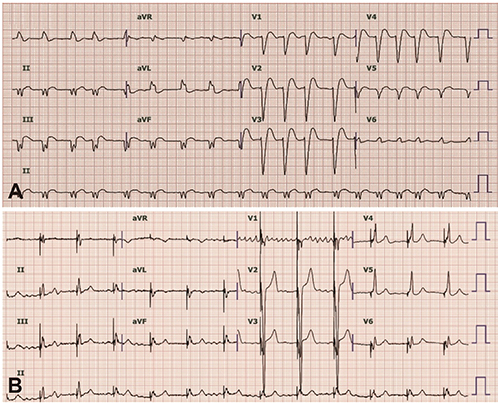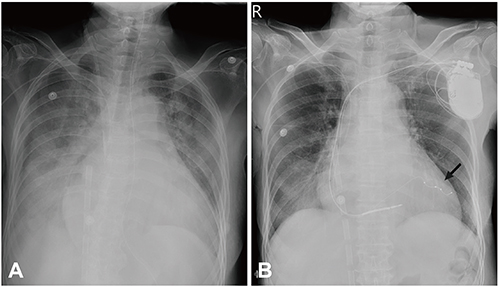Korean Circ J.
2017 Jan;47(1):132-135. 10.4070/kcj.2016.0176.
Cardiac Resynchronization Therapy Device Implantation in a Patient with Cardiogenic Shock under Percutaneous Mechanical Circulatory Support
- Affiliations
-
- 1Division of Cardiology, Department of Internal Medicine, Samsung Medical Center, Sungkyunkwan University School of Medicine, Seoul, Korea. choijean5@gmail.com
- 2Department of Internal Medicine, Samsung Medical Center, Sungkyunkwan University School of Medicine, Seoul, Korea.
- KMID: 2365292
- DOI: http://doi.org/10.4070/kcj.2016.0176
Abstract
- 65-year-old woman was admitted to our hospital with acute decompensated heart failure with reduced left ventricular ejection fraction and severe mitral regurgitation. Electrocardiography revealed a typical left bundle branch block and atrial fibrillation. Her condition deteriorated despite administering high-doses of inotropes and vasopressors. Pending a decision to therapy, venoarterial extracorporeal membrane oxygenation (ECMO) was performed when the patient underwent a cardiogenic shock. Although the hemodynamic status stabilized with ECMO support, weaning the patient from ECMO was not possible. Thus, we decided to perform cardiac resynchronization with defibrillator implantation as a "rescue" therapy. Five days post-implantation, the patient was successfully weaned from ECMO.
MeSH Terms
Figure
Reference
-
1. European Society of Cardiology (ESC). European Heart Rhythm Association (EHRA). Brignole M, et al. 2013 ESC guidelines on cardiac pacing and cardiac resynchronization therapy: the task force on cardiac pacing and resynchronization therapy of the European Society of Cardiology (ESC). Developed in collaboration with the European Heart Rhythm Association (EHRA). Europace. 2013; 15:1070–1118.2. National Institute for Health and Care Excellence. Implantable cardioverter defibrillators and cardiac resynchronisation therapy for arrhythmias and heart failure [Internet]. London (UK): 2014. cited 2014 June 24. Available from: https://www.nice.org.uk/guidance/ta314.3. Mantziari L, Guha K, Senguttuvan NB, Sharma R. Cardiac resynchronization therapy for critically ill patients with left ventricular systolic dysfunction. Int J Cardiol. 2013; 163:141–145.4. Sokal A, Jedrzejczyk E, Lenarczyk R, et al. Efficacy of cardiac resynchronisation therapy in the treatment of end-stage inotrope-dependent heart failure patients. Kardiol Pol. 2014; 72:777–782.5. Zaeem F, Giedriemiene D, Coleman C, et al. CRT-D Therapy in Patients with Decompensated NYHA Class-Four CHF. Cardiol Res Pract. 2012; 2012:319205.6. Bhattacharya S, Abebe K, Simon M, Saba S, Adelstein E. Role of cardiac resynchronization in end-stage heart failure patients requiring inotrope therapy. J Card Fail. 2010; 16:931–937.7. Pecha S, Yildirim Y, Reichenspurner H, Deuse T. Successful extracorporeal membrane oxygenation weaning after cardiac resynchronization therapy device implantation in a patient with end-stage heart failure. Interact Cardiovasc Thorac Surg. 2012; 15:922–923.8. Bang JH, Oh YN, Ko JK, Kang SY, Baek JS, Park CS. Cardiac Resynchronization Therapy in Infant with Dilated Cardiomyopathy during Extracorporeal Membrane Oxygenator. Korean J Thorac Cardiovasc Surg. 2015; 48:55–58.9. Cowburn PJ, Patel H, Jolliffe RE, Wald RW, Parker JD. Cardiac resynchronization therapy: an option for inotrope-supported patients with end-stage heart failure? Eur J Heart Fail. 2005; 7:215–217.10. Serri K, Lafitte S, Amyot R, Sauve C, Roudaut R. Echocardiographic evaluation of cardiac dyssynchrony. Can J Cardiol. 2007; 23:303–310.11. Moss AJ, Hall WJ, Cannom DS, et al. Cardiac-resynchronization therapy for the prevention of heart-failure events. N Engl J Med. 2009; 361:1329–1338.12. Leclercq C, Cazeau S, Le Breton H, et al. Acute hemodynamic effects of biventricular DDD pacing in patients with end-stage heart failure. J Am Coll Cardiol. 1998; 32:1825–1831.13. Upadhyay GA, Choudhry NK, Auricchio A, Ruskin J, Singh JP. Cardiac resynchronization in patients with atrial fibrillation: a meta-analysis of prospective cohort studies. J Am Coll Cardiol. 2008; 52:1239–1246.14. Pocock SJ, Wang D, Pfeffer MA, et al. Predictors of mortality and morbidity in patients with chronic heart failure. Eur Heart J. 2006; 27:65–75.15. Swedberg K, Komajda M, Böhm M, et al. Ivabradine and outcomes in chronic heart failure (SHIFT): a randomised placebo-controlled study. Lancet. 2010; 376:875–885.
- Full Text Links
- Actions
-
Cited
- CITED
-
- Close
- Share
- Similar articles
-
- Mechanical Circulatory Support in the Cardiac Catheterization Laboratory for Cardiogenic Shock
- Treatment of Advanced Heart Failure: Beyond Medical Treatment
- Short-term Mechanical Circulatory Support with Centrifugal Pump in Cardiac Arrest or Cardiogenic Shock: Report of 5 cases
- Mechanical Circulatory Support for Acute Heart Failure Complicated by Cardiogenic Shock
- Percutaneous left ventricular assist device: a systematic review




